Carbon dioxide paco2 - Study guides, Class notes & Summaries
Looking for the best study guides, study notes and summaries about Carbon dioxide paco2? On this page you'll find 1443 study documents about Carbon dioxide paco2.
Page 2 out of 1.443 results
Sort by
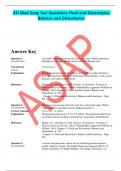
-
ATI Med Surg Test Questions Fluid and Electrolytes Balance and Disturbance
- Exam (elaborations) • 71 pages • 2023
- Available in package deal
-
- $17.99
- 1x sold
- + learn more
ATI Med Surg Test Questions Fluid and Electrolytes Balance and Disturbance Answer Key Question 1: (see full question) An elderly client takes 40 mg of Lasix twice a day. Which electrolyte imbalance is the most serious adverse effect of diuretic use? You selected: Hypokalemia Correct Explanation: Hypokalemia (potassium level below 3.5 mEq/L) usually indicates a defict in total potassium stores. Potassium-losing diuretics, such as loop diuretics, can induce hypokalemia...
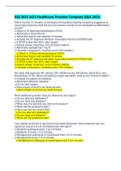
-
RQI 2025 ACLS Healthcare Provider Complete Q&A 2023.
- Exam (elaborations) • 6 pages • 2023
-
- $10.19
- 9x sold
- + learn more
RQI 2025 ACLS Healthcare Provider Complete Q&A 2023. Within the first 10 minutes, on the basis of the patient showing symptoms suggestive of myocardial ischemia, what will your first actions include (if not completed by EMS before arrival)? o Obtain a 12-lead electrocardiogram (ECG) o Administer a blood thinner o Administer aspirin and establish IV access o Activate the ST-segment elevation myocardial infarction (STEMI) team o If SPO2 is less than 90%, start oxygen o Assess airway, breath...
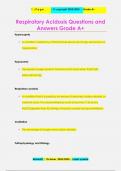
-
Respiratory Acidosis Questions and Answers Grade A+
- Exam (elaborations) • 20 pages • 2024
-
- $13.49
- + learn more
Hypercapnia A condition marked by a PaCO2 level above 45 mmHg. Also known as hypercarbia. Hypoxemia Decreased oxygen levels in the blood that result when PaO2 falls below 80 mmHg. Respiratory acidosis A condition that is caused by an excess of dissolved carbon dioxide, or carbonic acid. It is characterized by a pH of less than 7.35 and a PaCO2 greater than 45 mmHg. It may be caused by hypoventilation. Ventilation The exchange of oxygen and carbon dioxide. Pathophysiology and ...
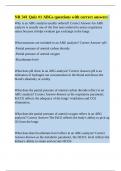
-
NR 341 Quiz #1 ABGs questions with correct answers
- Exam (elaborations) • 15 pages • 2024
-
- $15.99
- + learn more
Why is an ABG analysis usually ordered? Correct Answer-An ABG analysis is usually one of the first tests ordered to assess respiratory status because it helps evaluate gas exchange in the lungs. What measures are included in an ABG analysis? Correct Answer--pH -Partial pressure of arterial carbon dioxide -Partial pressure of arterial oxygen -Bicarbonate level What does pH show in an ABG analysis? Correct Answer-pH is an indication of hydrogen ion concentration in the blood and shows the...
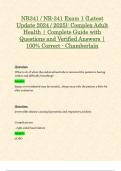
-
NR341 / NR-341 Exam 1 (Latest Update 2024 / 2025): Complex Adult Health | Complete Guide with Questions and Verified Answers | 100% Correct - Chamberlain
- Exam (elaborations) • 55 pages • 2024
- Available in package deal
-
- $7.99
- + learn more
NR341 / NR-341 Exam 1 (Latest Update 2024 / 2025): Complex Adult Health | Complete Guide with Questions and Verified Answers | 100% Correct - Chamberlain Question: What to do if when the endotracheal tube is removed the patient is having stridor and difficulty breathing? Answer: bipap or re intubated may be needed.. always stay with the patient a little bit after exubation Question: irreversible disease causing hypoxemia and respiratory acidosis Complications: - right sided ...
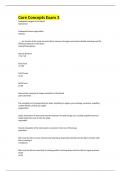
-
Core Concepts Exam 3
- Exam (elaborations) • 20 pages • 2024
- Available in package deal
-
- $10.49
- + learn more
Core Concepts Exam 3 Inadequate oxygen in the blood hypoxemia Inadequate tissue oxygenation hypoxia ___ are invasive & the most accurate direct measure of oxygen and carbon dioxide exchange and the acid-base balances in the blood arterial blood gasses Normal pH level 7.35-7.45 PaO2 level 75-100 PaCO2 level 35-45 HCO3 level 24-28 Noninvasive measure of oxygen saturation of the blood pulse oxometry The complete act of oxygenating the body; breathing...
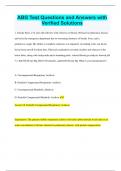
-
ABG Test Questions and Answers with Verified Solutions
- Exam (elaborations) • 26 pages • 2024
- Available in package deal
-
- $9.99
- + learn more
ABG Test Questions and Answers with Verified Solutions 1. George Kent, a 54-year-old widower with a history of chronic obstructive pulmonary disease, arrived at the emergency department due to worsening shortness of breath, fever, and a productive cough. His ability to complete sentences was impaired. According to his son Jacob, he has been unwell for three days. Physical examination revealed crackles and wheezes in the lower lobes, along with tachycardia and a bounding pulse. Arterial...
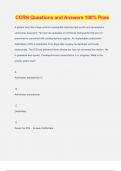
-
CCRN Questions and Answers 100% Pass
- Exam (elaborations) • 59 pages • 2024
-
- $13.49
- + learn more
CCRN Questions and Answers 100% Pass A patient has had a large anterior myocardial infarction last month and developed a ventricular aneurysm. He now has episodes of ventricular tachycardia that are not prevented or converted with antidysrhythmic agents. An implantable cardioverter- defibrillator (ICD) is implanted. Four days after surgery he develops ventricular tachycardia. The ICD has delivered three shocks but has not converted the rhythm. He is pulseless and apneic. Cardiopulmonary re...
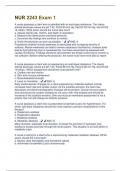
-
NUR 2243 Exam 1 All Possible Questions and Answers 2025
- Exam (elaborations) • 44 pages • 2024
-
- $8.39
- + learn more
A nurse assesses a client who is admitted with an acid-base imbalance. The clients arterial blood gas values are pH 7.32, PaO2 85 mm Hg, PaCO2 34 mm Hg, and HCO3 16 mEq/L. What action should the nurse take next? a. Assess clients rate, rhythm, and depth of respiration. b. Measure the clients pulse and blood pressure. c. Document the findings and continue to monitor. d. Notify the physician as soon as possible. - ️️ANS: A Progressive skeletal muscle weakness is associated with increasi...

-
2022/2023 NRNP 6566 Final Exam Study Guide | Week 6-11 Fully Covered.
- Exam (elaborations) • 64 pages • 2023
-
- $11.99
- 1x sold
- + learn more
2022/2023 NRNP 6566 Final Exam Study Guide | Week 6-11 Fully Covered. Final Exam-Study Guide Week 6 and 7 1. Interpret arterial blood gases (ABG). Differentiate alkalosis/ acidosis and respiratory / metabolic 2. Identify a ventilation – perfusion mismatch and how to treat it If there is a mismatch between the alveolar ventilation and the alveolar blood flow, this will be seen in the V/Q ratio. If the V/Q ratio reduces due to inadequate ventilation, gas exchange within the affected alve...

How did he do that? By selling his study resources on Stuvia. Try it yourself! Discover all about earning on Stuvia


